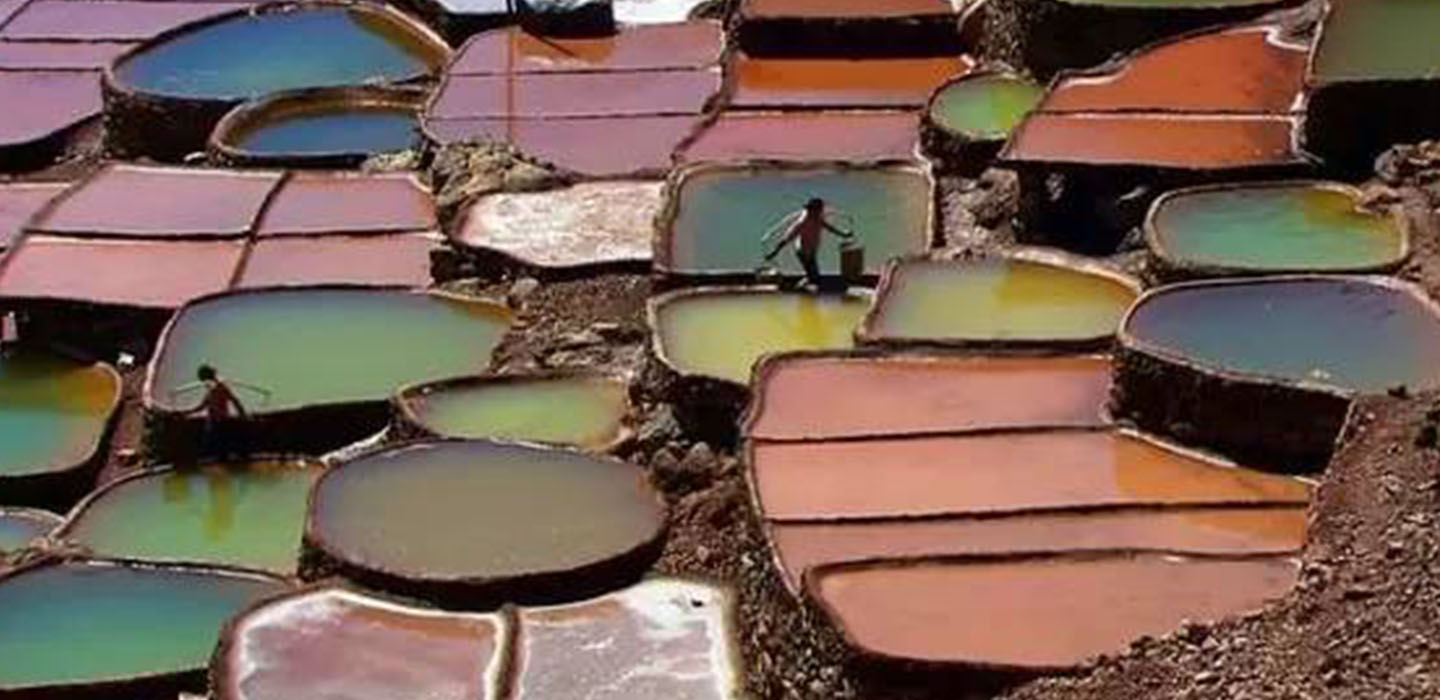瀾滄江畔氣候宜人、風景獨特。西藏東南面有個地方叫鹽井,古老的茶馬古道由此進入西藏。鹽井以出產井鹽而得名,在瀾滄江東西兩岸的沙灘和懸崖陡坡上,層層搭建四千幾塊鹽田,300多個鹽池 ,層層好似一排排的朱古力。
鹽井藏名為「擦卡洛」,「擦」意思是鹽。早在唐朝芒康鹽井就有曬鹽的歷記載, 距今已有近 1300 年歷史。在瀾滄江邊岩鏠中有含鹽量極高的滷水由井自然湧出,當地的鹽民將滷水注入一格格的鹽田,經過風吹日曬自然蒸發,鹽田上便會結晶出鹽粒,這是世界上僅存最古老的製鹽方式。進入鹽井看到房頂潔白鹽晶,房內有如鍾乳的晶鹽,好似進入了水晶宮的世界。
當地鹽民們用木桶或管子從鹽井中取出鹵水,倒入或灌入各自的鹽田,陽光蒸曬成為粗鹽,再經晾曬打理而成食鹽。由於地質、土壤條件的差異,雖然同取一江之水,兩岸的鹽田竟然出產不同顏色的鹽,西岸鹽田的鹽是紅色,東岸上下鹽井村的鹽田卻是白色,白鹽是人食的,江西生產的紅鹽主要動物食用。牧區最喜歡紅鹽,原來牲畜吃了紅鹽後,身體長得較為結實而且多肉。
每年的3月至5月是曬鹽的黃金季節,陽光明媚,河谷的風非常強勁,令鹽田更容易出鹽,這時鹽的品質是最好的。此時也正是瀾滄江兩岸桃花陸續開放的時節,這些在「桃花月」曬出的鹽被稱為「桃花鹽」。
目前從事這古老製鹽業的仍然以老人家或當地婦女為主,製鹽技術又以家庭式作業,古老製鹽業面臨失傳的危機。為了挽救及保留這一獨有的製鹽歷史,當地政府己成立了鹽井古鹽田縣級文物單位進行保護,包括將被洪水淹沒的鹽田進行搬遷。
獨一無二的原始曬鹽方式及自然風景每年吸引大批遊客慕名而來,帶動當地的零售及旅遊業,鹽井古鹽田努力創建為5A級景區,希望讓更多人到當地感受獨特而原始淳樸的民俗風情,親身觀賞及體驗手工製鹽的全過程。
The Lancang River belongs to an area with a moderate climate, but truly breathtaking natural scenery. In the southeast of Tibet, there is a place called Yanjing where the ancient Tea Horse Road entered Tibet.
Yanjing in Chinese means "Salt Well", which is named after the springs found in this area. On the beaches, slopes and cliffs that surround the Lancang River, there are more than 4,000 salt fields and 300 salt ponds built up in layers, resembling rows and rows of chocolates.
The Tibetan name of the salt well is "cakalo", "ca" meaning salt. As early as the Tang Dynasty, there are records of salt tanning in the salt wells of Mankang, which has a history of nearly 1,300 years. The brine with very high salt content naturally gushes out from the wells in the rock crevices along the Lancang River.
Local salt makers inject the brine into a grid of salt fields, and after natural evaporation by the wind and sun, salt grains would crystallize on the salt fields, which are the oldest example of salt production in the world today.
After entering the salt well, you can see the white salt crystals on the roof and crystal salt like stalactites inside the room, as if entering a magical land of glistening crystal.
Local salt makers use wooden barrels or pipes to extract brine from the salt wells, pour them into the salt fields, where they are steamed and dried in the sun to become coarse salt, and then dried and tended to make cooking salt.
Due to differences in geology and soil conditions, the salt fields on both sides of the river produce different colors of salt, even though the water originates from the same river.
Salt from the salt fields on the west bank is red, while the salt fields in Yanjing village on the east bank are white. The white salt is for human consumption, while the red salt produced there is mainly used for animal consumption. The red salt is most popular in pastoral areas, and it turns out that animals grow stronger and more succulent after feeding on red salt.
March to May is the golden season for salt tanning when the sun is shining, and the wind blowing through the valley is particularly strong, making it easier for the salt fields to produce salt, and the best quality possible. This is also the season when peach blossoms open on both sides of the Lancang River with the salt produced during this time popularly known as "peach blossom salt".
At present, the old salt industry is still dominated by the elderly and local women. The salt-making technology is home-based, and the old salt-making industry is in danger of being lost. In order to save and preserve this unique history of salt making, the local government has set up a county-level cultural heritage unit to protect the ancient salt fields of Yanjing, including relocating the flooded salt fields.
The unique salt tanning method and natural scenery draws a large number of tourists every year, driving the local retail and tourism industry. The Yanjing Ancient Salt Field is striving to attain Grade 5A scenic spot status, hoping to bring more people to the area to experience its unique folklore for themselves, And of course to see and experience the entire process of truly hand-made salt.

